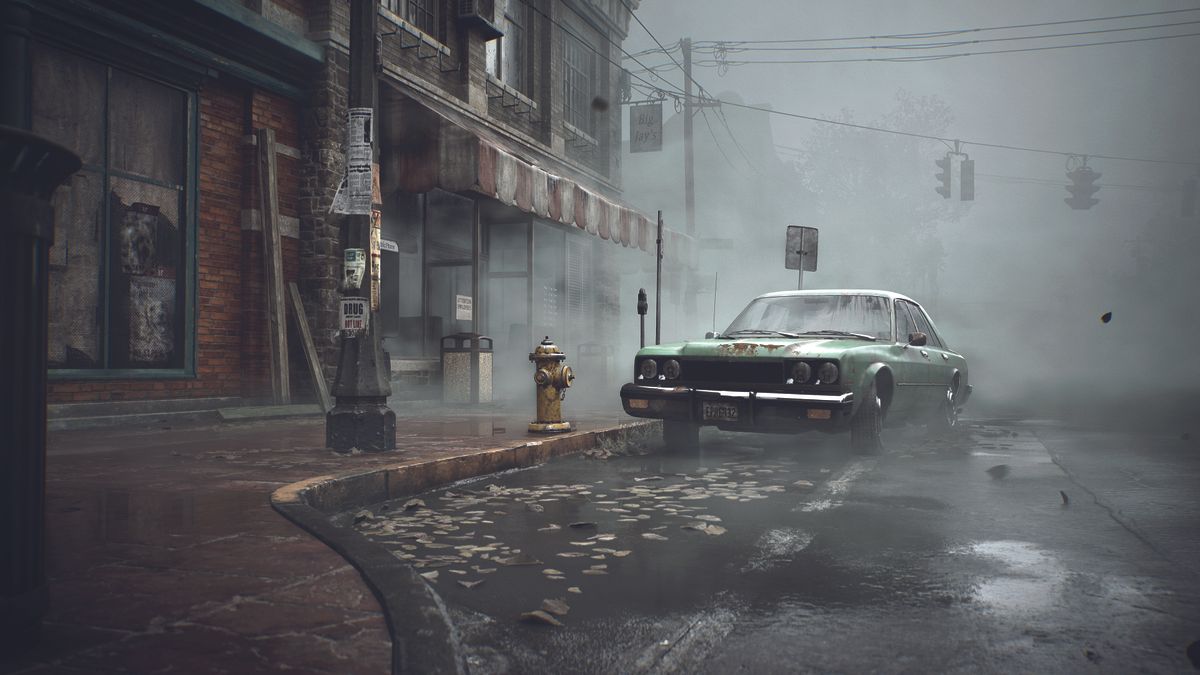Mary waits for James in their ‘special place,’ the town of her restless dreams, Silent Hill. An odd choice considering it’s a resort spot foggier and drearier than a British summer, not to mention a mite more dangerous. Odder still is the fact that dear old Mary is supposed to be dead. So, what does this letter to James truly say?
For many horror fans, Silent Hill 2 itself is a special place of sorts. Released on PlayStation 2 in 2001, its mature story sees James struggling with his own inner demons as much as the town’s fleshy horrors in ways far ahead of its time. As in the very first series entry on PS1 before it, waves of fog cleverly took advantage of a draw-distance consideration to generate unease.
But on PS2 improved graphics meant more detailed nightmares chased after James, and wonderfully grimy textures gave the town real, tangible character that kicks into overdrive when the place goes from being simply run down to a rusted-over nightmare as James wanders in and out of alternate Otherworld versions of Silent Hill.
Remaking a classic using Unreal Engine 5
Stumbling through foggy streets and pitch-black hallways at a fixed distance made James truly feel like a lost soul, while brief encounters with the other troubled people drawn to the liminal town offered cryptic insight.
How do you remake and modernise a game like Silent Hill 2, which is so defined by the conditions in which it was originally released? How do you maintain the claustrophobic atmosphere, a result of technical shortcomings when the remake is running on Unreal Engine 5, a game engine best known for its realistic levels of detail?
“We fully understand that Silent Hill 2 holds a special place in many people’s hearts as being memorable and as a masterpiece,” acknowledges the series’ lead producer Motoi Okamoto. “So by introducing the remake of this game as the very first major title, we wanted to [demonstrate to] all of our players, all the fans, that Konami is serious about [renewing] the series, and that we are capable of delivering a high-quality Silent Hill game.”
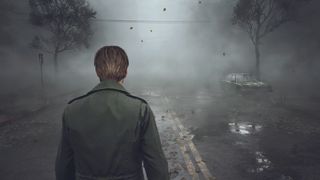
The answer Konami and Bloober Team have arrived at is to remain as faithful to the original as possible, while doing everything they can to heighten the sense of tension and unease. (If you like the sound of this, read our making of UE5 horror game Still Wakes The Deep.)
The most obvious change I notice when going hands-on is how much closer the camera is to the action, framing tightly over James’ shoulder. Watching James getting lost from afar was scary enough, but now we’re better brought into the action, fighting our way through the fog just like he is.
It’s a claustrophobic and uncomfortable viewpoint that’d be annoying in a lot of other games, but works wonderfully here, especially when I let my guard down. There’s no escape, with every new corner soon becoming one that you hesitantly poke your head around, edging into the unknown of your telly screen. Every gruesome horror out to lunge at James is also lunging at you.
But before the nightmare truly begins to tighten around James’ psyche, I need to rewind to the ratty bathroom in which he’s splashing his remade, stubbly mug with water, pondering Mary’s letter. All in one cutscene, I follow him outside to the observation deck where he’s parked his car, giving him a view that’s so much more than a splash of flat texture, taking a wide view of the mirror-like surface of Toluca Lake, which cradles the town.
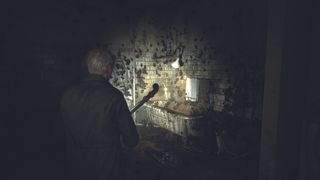
Gaining control, I do what any survival horror gamer does best: rifle through James’ car. Picking up the map that’s still on the back seat, we venture toward town along a woodland walk. James’ initially slow pace leaves room for atmosphere, especially as a gentle haptic rumble from the DualSense plays on our fears that something just out of shot may be following close behind.
Soon picking up the pace with I gladly take off in what I’d hesitate to call a sprint; it’s more of a jog. This James has been at the cardio, though – while he does sound a little out of breath from time to time, he’s able to keep moving at pace without worrying too much about stamina management (putting world-famous author Alan Wake to shame).
Partway down the path I come across a graveyard and meet Angela, a woman drawn to the town in search of her family, who warns us of its danger – not that James cares. Mary’s letter compels him, though it’s not the only thing rattling around in his head. A save point in a nearby well draws us close in to checkpoint our progress, and James comments that it feels like someone is rooting around his skull. It’s a neat metatextual touch that reminds us that as close as we are to James, we’re still a distinct, voyeuristic entity merely puppeting his actions. Might this be something the remake plays with later on?
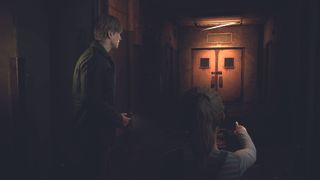
Sploshing underfoot, I realise that as faithful as my chat with Angela was to the original (the new voice acting is effective), some changes have been made. The church grounds are now half-flooded, Toluca Lake’s water encroaching into the town’s reality. What is fog, after all, but water vapour? – and I run the risk of becoming fully submerged.
There’s still only one path forward, just like in the original. Jogging past the unsettling cornfields of Silent Hill Ranch, windswept rustling makes you second-guess at the Kingian nightmare hidden within.
Silent Hill 2 Remake goes the extra mile
While the ranch is only somewhere we walk by, other parts of the town have been expanded and renovated with an extra coat of peeling paint. Before I can enter the town proper, I reach a new locked gate connected to Auto Service & Tires. A note from the mechanic says they’ve popped into town, and that spare keys are in the drawer. Judging by the yellowed, weathered paper it seems he left some time ago, but the sound of a bolt tinkling along the floor within makes us wonder if the place really is empty.
I vault through the window – a new traversal move that can be used by James and enemies alike – and begin to explore the building. This is the first of many fresh detours that make Silent Hill feel more like a once-lived-in place than a lineup of doors too rusty to open. James, on the other hand, isn’t standing still, with a quick-turn helping me to check my six. Both the map and quick-use items can be easily accessed with single button presses (and your full inventory is slick to navigate from the touchpad).
Creeped-out but safe, I keep moving forward and feel increasingly confident in my movement. The layout of the town’s streets feels faithful to what I remember from the original, but here they’re richly detailed and better built-out – it’s like navigating a space I half-remember from a dream. But, ah, that blood splatter is hard to forget, as is the oddly shaped silhouette shambling into the fog ahead. (Read Maxim Dorokhov’s UE5 interiors tutorial for an insight into these kinds of environments can be made.)
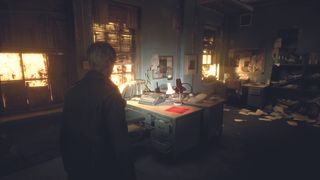
Following the trail – perhaps unwisely – I’m led on by sounds of crooning and clattering. Before we can make sense of what’s drawing near as we approach in the fog, it crashes through a fence and barrels into a nearby townhouse. I follow. These vacuum-packed creatures make a lot more sound than before – it almost feels like chasing a gremlin along its trail of destruction. James calls, limply, “Hello?” If it were us in this situation, we’d definitely be muttering more expletives. Then again, we’d probably not follow the blood trail even further into the foggy, bad-vibes town either.
A hole in the house’s garage is wreathed in white cloth, signposting areas of interaction – there’s no yellow paint here. James gets on his belly and crawls through, before then shimmying through a gap in a brick wall. The townhouse feels fairly ’50s, but with rotting paint peeling away. Undeterred by the horror, there’s time to rifle through drawers and stuff health drinks into our pockets before the low ebb of radio static rises.
A fleshy figure crashes through the bare boards of the opposite wall. Before I can even register what it is, I react, bashing it with a loose plank of wood. I dodge its sickly spewing, before charging ahead and knocking it flat. I brutally finish off the whining creature. “Whatever it is, it’s not human,” mutters James. Get this guy a detective game, stat.
The radio crackles back to life, but instead of heralding danger it now gives way to a voice calling out to James: Mary’s.
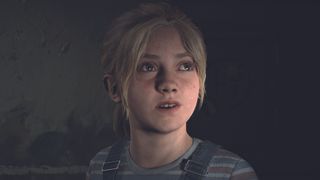
The connection is bad, but it’s enough to encourage me to press forward. The tussle inside is just a precursor of what’s to come, the streets sparsely (for now) populated by horrors ready to get the jump on us whenever the radio buzzes. Stocking up on health drinks (and, later, ammo) will be vital, but it’s up to you whether you want to explore every nook and cranny available, as dangers lie in wait as well. Some valuable resources are even hidden in cars, meaning James has to smash the glass to get his hands on them, shards tumbling away differently each time.
The path forward closely resembles the chain of clues that leads you all over town in the original game, but each location has more character – from the dilapidated Neely’s Bar being more than just a burnt-out husk (though still housing hella ominous graffiti) to Saul Apartments giving you multiple new developments to poke around. Detours like this feel like worthy additions to James’ journey, being additive without compromising the foundations of what came before. It feels like there’s more lore to pick through, but from what we’ve seen it stops short of being too on-the-nose.
A truly unsettling playlist scores this intro, though long-time Silent Hill composer Akira Yamaoka explains that “all of the tracks [you’ll recognise] have been reworked from the ground up.” With nine hours of music (longer than Wagner’s Ring Cycle, as a Konami PR helpfully notes), from industrial arrangements that leave you on edge to melancholy guitar riffs, he quips “How in the world are we going to fit all this into a soundtrack?” Acknowledging that the remake will be as much for new fans as those who loved the original, Yamaoka says of the new arrangements that “We want to make sure everyone has a fresh experience.”
Complex, frighteningly good world design
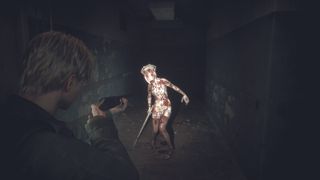
Which means it’s a good couple of hours before I even get to the Wood Side and Blue Creek apartment blocks – the first major interior location in the original game. If you’re concerned about the remake being more action-heavy, you needn’t worry; if anything the remake’s intro is a slower, steadier build.
“It was very tricky, because obviously you want to stay true to the original, and the original was very slow at the beginning,” shares Maciej Głomb, lead producer at Bloober Team (the developer previously impressed with its UE5 remake of Layers of Fear). “We actually discussed a lot of different approaches to that; we discussed making it more action-heavy at the beginning,” he continues. “But, this is, you know, Silent Hill – this is why we made the choice to keep it as it was and only pick up the pace after some time.”
That’s what informed the additive approach, rather than over-seasoning Silent Hill 2’s original secret sauce. Mateusz Lenart, Bloober Team’s creative director, adds: “At the very beginning, we didn’t want to change anything completely, because we were too afraid of [even] touching the game.” It’s understandably daunting, but taking no chances at all would make us wonder ‘What was the point?’ Lenart continues, “[But] after a time, we [saw] that [we needed] to expand on [the original] to create a game that would be competitive in this generation of consoles.”
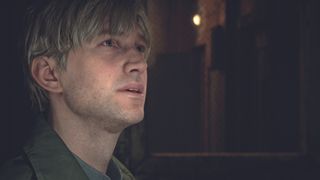
The terror simmers as I pick through the apartments. You’d best believe this maze of doors has odd obstructions, missing handles, locked doors, and arcane codes to break. The unsettling feeling of being in a building with so many walls hiding lord knows what is emphasised here in the remake to great effect. There’s always the sound of something bad happening mere floors above, distant screams or muffled gunfire deadened by layers of wood and memory.
Threats start out imagined, but quickly move into the real after you’ve got a few tricksy puzzles under your belt (and yes, these conundrums have their own difficulty settings). More of the strange, wrapped-up figures wriggle across the ground, lulling us into a false sense of security as later hallways host enemies that move like nothing in the original, crawling along the walls with twisted limbs. Reader: when we see them, we shriek, and we can’t count the number of times we’ve replayed Silent Hill 2.
“As for the creatures we have some minor updates,” undersells Motoi Okamoto, as he introduces us to a new variant of the mannequins, named the spider mannequin. “We have also replaced and remapped all the enemies from where they were placed in the original so everyone can have a fresh take on combat,” he adds.
At least I have an excuse for the shrieking. And so too do the monsters – the ever uncomfortably vocal enemies are even more so, leaving us paradoxically concerned about the strange, twitching bodies we pummel to bits.
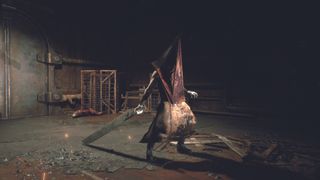
Creature designer and Silent Hill vet Masahiro Ito tells me that all the redesigns are faithful to the team’s original visions. Most changes have been informed by improvements to the combat mechanics with, he notes, “some minor variance – some very visual, slight changes to all of the enemy designs.”
Some of these terrors are more demanding to deal with, of a piece with the series’ more action-heavy contemporaries, but crucially, even after I pick up a handgun from a bullet-splattered room, combat still isn’t the focus. “While we have said that we have revamped and reworked the combat design overall,” Ito continues, “we want to place emphasis that this game is not supposed to be oriented heavily towards combat.”
One Ito design in particular emphasises this: the Executioner, or the Pyramid-Headed thing himself. Teased out of reach at first, I get up close and personal for the first time when James passes through an apartment only to realise the creature is scarcely inches away. Hiding in a closet as the horror brutally attacks a mannequin, it gets a bit Blue Velvet as the Pyramid Head discards its prey and draws close. Readying the gun, James opens fire, but the thing barely reacts before shambling away.
It’s clear from here that methodically clearing rooms isn’t Silent Hill’s way. In some situations, you’re better off aiming to survive to fight another day – as long as you’ve got enough resources to keep pushing forward. Puzzles abound, from clocks to murals, but the thought of that lurking creature lingers, and when we think we’re nearly free of the oppressive buildings, we’re cornered – just a hulking man with a strange metal head, an extremely long sword, and me with nowhere to run. The horror is real.
Silent Hill 2 Remake will release 8 October for PlayStation 5 and Microsoft Windows. Find more details on the Konami website. Inspired? Then read our guide to the best laptops for game development and start creating for yourself.
